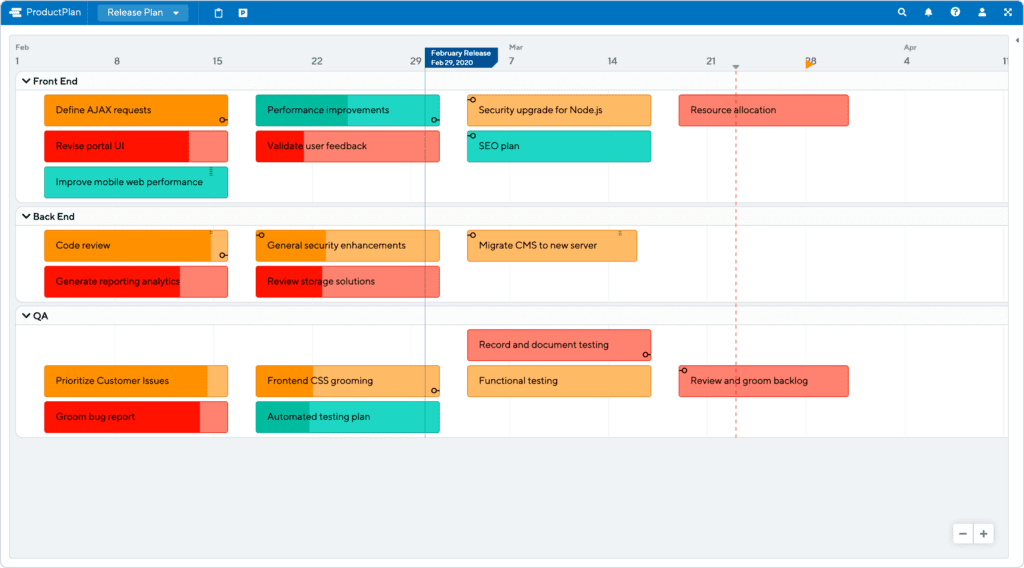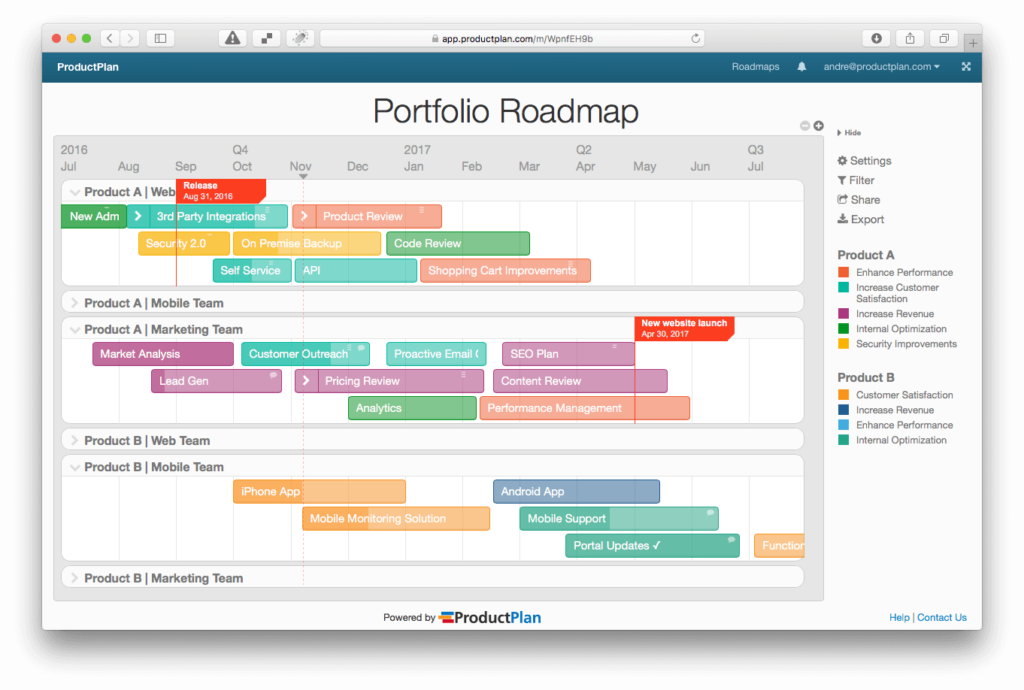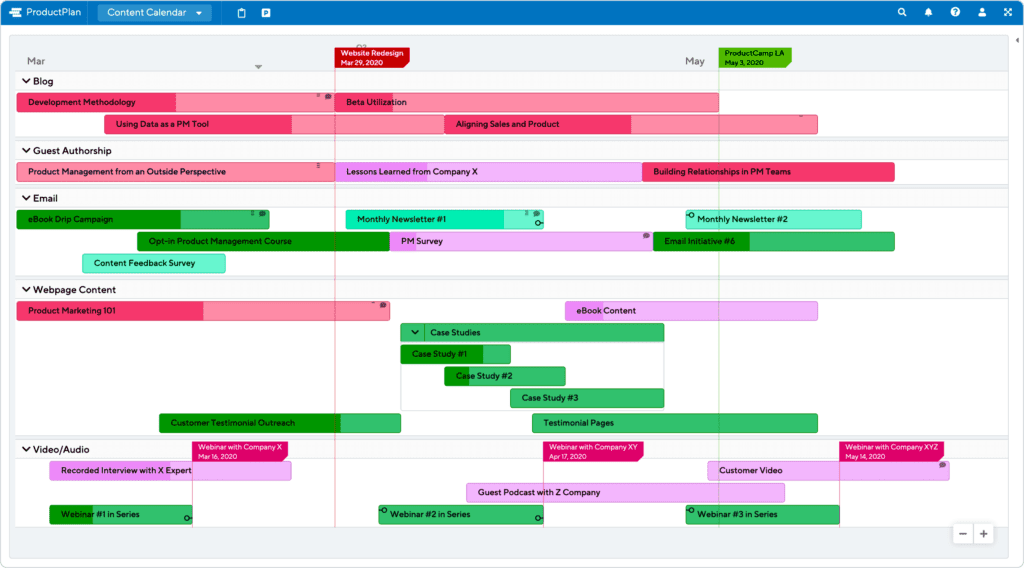When product managers think of roadmaps, we understandably think first — and often only — about the product roadmap.
And although we may primarily think of roadmaps as product tools, why limit them to just that? Roadmaps can be an invaluable strategic tool for communicating and planning a variety of projects. So why shouldn’t we utilize the same benefits of maintaining a product roadmap for our other projects and initiatives?
With the right roadmap tool, we can develop visual, easy-to-share strategic documents. Using the product roadmap format, we can apply the same principles to help us track and communicate many essential undertakings. Here are a few example templates of non-product roadmaps that you and others across your organization might find valuable.
3 Roadmap Template Examples for Project Management, Engineering, Marketing, or Other Groups
Release Plan Template
 We typically think of a release plan as a method used by a project manager to track the execution details of a product roadmap. Unfortunately, many release plans become a long static list of tasks in a document or spreadsheet — but there is a better way!
We typically think of a release plan as a method used by a project manager to track the execution details of a product roadmap. Unfortunately, many release plans become a long static list of tasks in a document or spreadsheet — but there is a better way!
With the right roadmap software, you can develop, manage, and share a much more user-friendly release plan — one that lets you roll up tasks into groups, organize and view projects according to their priority, and quickly and easily update your release plan as often as you need.
Take a look at the release plan example above developed using roadmap software. This plan has an easy-to-view format that lets the user quickly identify group-level initiatives, determine their priority level, and observe where they’re slated for completion on the calendar. From this high-level view, the user can drill into any of these initiatives for a more granular view of the individual tasks associated with each.
Portfolio Roadmap Template
 A portfolio roadmap allows you to take a higher-level view of your products’ strategic plans and objectives. If you manage multiple products, there are many benefits of creating a portfolio roadmap.
A portfolio roadmap allows you to take a higher-level view of your products’ strategic plans and objectives. If you manage multiple products, there are many benefits of creating a portfolio roadmap.
A product roadmap helps you develop and communicate how your product relates to your company’s larger objectives. As such, a valid product roadmap needs to be grounded in reality — treating your product’s development not in a vacuum but relative to the company’s other projects competing for your limited resources.
A portfolio roadmap is a great way to extend this strategic view out to other related products you are also managing — so that you and all stakeholders can see how development or other resources expended in one area (or on a single product) will affect the progress of other products in the portfolio.
Another reason a portfolio roadmap can be valuable is that it can help you and your stakeholders identify the synergies involved in developing related products or products that share internal resources or user personas.
You see that your product marketing team slating to spend two weeks developing an SEO plan for Product A, and you realize that a slight tweaking of that plan will also make it valid for Product B. So you might decide to extend PMM’s time on Product A’s SEO by another week — because they will already be creatively focusing on it and knee-deep in the research — so they can also build out the SEO plan for Product B.
As you can see from the example portfolio roadmap above, having a portfolio roadmap gives you an even higher-level and more strategic view of your products’ development and objectives. And because it presents such a strategic-level view, you can also easily share it with your internal and external stakeholders.
Content Calendar Template
 While spreadsheets can work here as well, they can quickly become too long and cumbersome to maintain. At that point, it becomes too difficult to share with relevant stakeholders without first giving them a thorough walkthrough on how to read and understand the document.
While spreadsheets can work here as well, they can quickly become too long and cumbersome to maintain. At that point, it becomes too difficult to share with relevant stakeholders without first giving them a thorough walkthrough on how to read and understand the document.
But with a roadmap software tool, you can approach your content calendar as you would a product — and roll up your tasks (think features or stories) into groups (consider themes).
You can see from the example content calendar above that you can create groupings by content type — such as blogs, email blasts, web pages, etc.
You can also color-code your tasks or tasks to indicate the party responsible, the goal, or the priority level. And you can easily layout these groups against a timeline backdrop to make it easy to view the planned order of release.
Roadmaps Template Examples Can Be Useful Than You Realize
The key to identifying more of the many ways you can leverage the benefits of roadmaps is to understand why we use product roadmaps in the first place.
Suppose you manage products, particularly in a fast-moving company or agile environment. A high-level view of your vision and goals serve as a reminder to yourself and your team the “Why” of what you’re doing.
So you can also use the roadmap format to quickly return to the strategic, big-picture level with other aspects of your role. Why not use a roadmap to develop, track and share your…
- User survey strategy
- Sales training plans
- Pricing scheme
In the day-to-day details of your job, it’s easy to get lost in the weeds — and lose sight of the bigger strategic picture of what you’re doing. Maintaining a roadmap will help you reorient yourself — and bring you back to the strategic view you need to make the right decisions. If you get creative, you can find plenty of ways to become more productive and make better-informed decisions using the right roadmap software.
And if you have any other examples of how you’ve used a roadmap to track and share other strategic elements of your job or your organization, please share them in the comments below.


